Sensory Reliance
Vision was used in big majority of food evaluations, highlighting its primary role in vervet monkeys foraging behaviours.
Vervets possess trichromatic colour vision, a trait associated with improved food selection accuracy. Suggests vervets are well-adapted to visually driven environments. The findings in this study are consistent with other findings in diurnal primates.
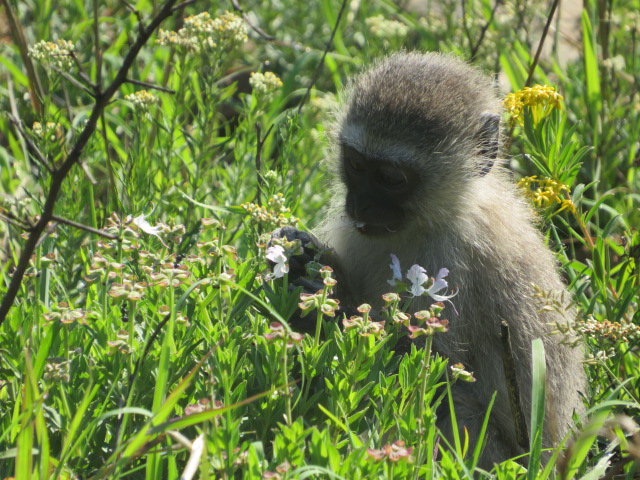
Touch was the most common non-visual sense.
This suggests that the vervets may be evaluating aspects such as texture, firmness, or weight, particularly when handling food items prior to consumption. The patterns have been seen in other omnivorous primates, which rely on manual touch due to complex diets.
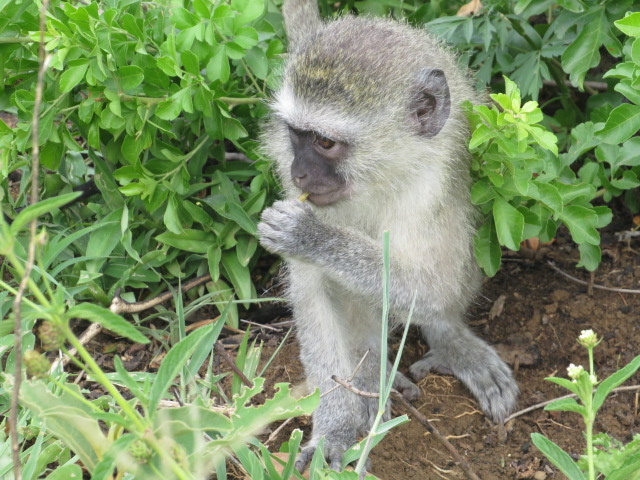
Olfaction and Taste were used less than touch.
This is supported by findings that dichromatic primates use olfaction more than trichromats. Suggests chemical cues are secondary, engaged mainly during uncertain or novel food encounters. Could reflect the absence of toxic foods, reducing the need for intensive chemical evaluation.

Sensory Hierarchy:
vision > touch > olfaction > taste
The vervets’ reliance on vision reflects cognitive efficiency in food selection, while selective use of other senses reflects flexibility when confronting unfamiliar foods.
Food Preferences
Vervets have an Omnivorous Diet!
High consumption of leaves and unknown items.
Given that the data were largely collected during the dry season — a period of reduced food availability — this pattern may reflect an increased reliance on fallback resources.
Fruits and flowers were less consumed (among the most consumed categories).
The relatively low consumption of these two categories compared to leaves may indicate limited availability due to the season or a preference for alternative resources.
Arthropods was the most consumed item (among the less eaten categories).
This suggests that while they may serve as an important source of protein , they are not a primary component of the diet. Additionally, the seasonal variation in arthropod abundance could further explain their limited overall contribution to the vervets’ diet
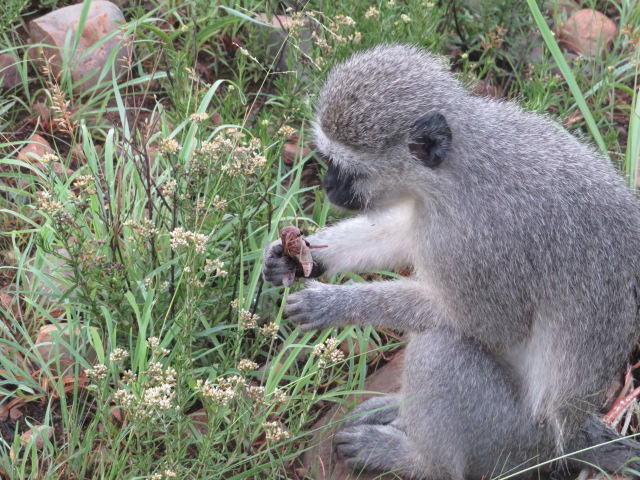
Unknown items elicited the highest sensory engagement, especially non-visual cues.
This indicates that vervets follow a hierarchical process during food evaluation — using vision for the initial assessment, followed by touch for more detailed examination when needed, and then relying on smell and taste.
Vervets are Efficient in Food Selection!
The low rejection rate of food items suggests a high degree of dietary flexibility among vervets, potentially reflecting a low presence of toxic or harmful foods in the environment. For familiar food items, visual inspection appears to dominate the evaluation process, allowing individuals to minimize the use of additional sensory modalities and thereby reduce unnecessary effort during foraging.
Muzzle Contact
These results were not statistically significant, so this patterns should be interpreted cautiously.
Muzzle contact was observed primarily with fruits, flowers, bark, and leaves, and occurred more frequently when individuals encountered less familiar food items.
It was absent in interactions involving seeds, gum, roots, fungi, and arthropods — possibly due to quicker consumption, greater familiarity, or lower availability of these items.
This behavior likely plays a role in social learning, particularly in the context of novel food exploration.
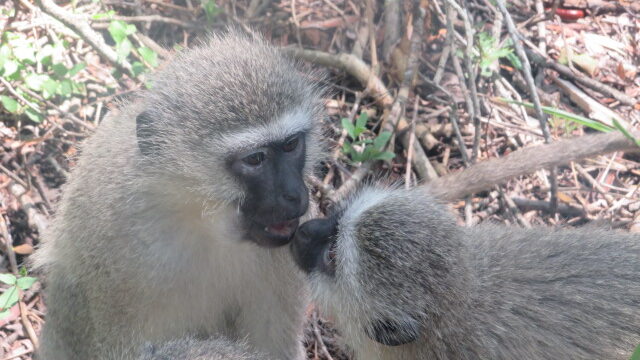
Sex, Age and Social Group Differences
Females vs. Males
Females touched food slightly more often than males, suggesting a more cautious and deliberate evaluation strategy. This aligns with findings indicating that females tend to be more selective in their food choices, likely due to the nutritional demands associated with reproduction.
Additionally, the significantly higher rates of receiving muzzle contact observed in females may point to their greater involvement in food-sharing interactions and the reinforcement of social bonds.
Infants vs. Juveniles vs. Adults
Adults relied on vision significantly more often than infants and juveniles, likely reflecting greater experience and efficiency in food evaluation.
In contrast, infants and juveniles engaged in more exploratory and multisensory strategies, indicative of an ongoing learning process in food discrimination, although these differences were not statistically significant.
The significantly higher consumption rates observed in adults further support the idea that experience enhances efficiency in assessing and selecting food items.
Baie Dankie vs. Ankhase
Baie Dankie (BD) group used touch significantly more frequently than the Ankhase (AK) group, suggesting potential environmental or cultural variation in foraging strategies.
This difference may reflect socially transmitted behaviors shaped by local ecological conditions, highlighting the role of social learning and environmental context in shaping sensory use during food evaluation.
Sensory-Based Decision-Making
Most of corn evaluations followed a Vision/Consumption sequence.
This indicates that vervet monkeys primarily rely on visual cues when assessing familiar foods like corn, which they had been repeatedly exposed to during habituation. This aligns with previous findings on primates!
Full sensory sequences were more common with: peppermint, bitter almond, and green-bitter almond corn.
This supports the notion that primates engage in more careful evaluation when encountering novel or chemically altered foods. Non-visual cues play a key role in assessing the safety and palatability of unfamiliar items, helping to avoid toxicosis and enhance foraging efficiency.
Responce to Novelty and Habituation
Minimal differences between normal and coloured corn suggest colour alone does not strongly influence sensory engagement.
Green and red corn were accepted with minimal sensory evaluation, suggesting they were perceived as familiar or safe.
Green likely familiar due to resemblance to naturally consumed items (fruits, leaves, seeds).
Red may have been associated with sweetness due to prior exposure in experiments with these specific monkeys for habituation purposes.

Primates exhibit food neophobia, increasing sensory investigation for novel or potentially risky foods.
Vervet monkeys relied more heavily on vision and smell during initial encounters with food, then reduced sensory assessment once the food was deemed safe.
Blue corn showed a significant decrease in vision and olfaction from 1st to 2nd presentation. This indicates initial caution due to unfamiliarity, since blue is rare in natural food sources, supporting the idea that unfamiliar colours trigger increased sensory assessment.
Peppermint corn triggered the highest sensory evaluation among scented corn types, suggesting that strong or potentially aversive odors prompt increased caution.
Green-bitter almond corn had the highest engagement among dual-modified types, demonstrating that scent can override familiarity with colour cues.
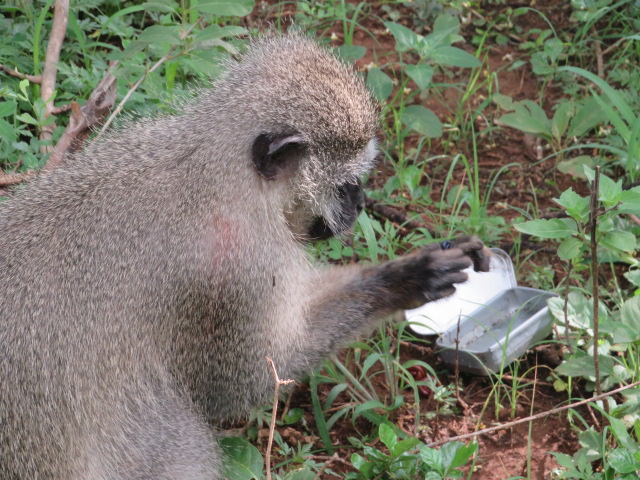
Decrease of evaluation time with continuous exposure.
Significant decline in sensory evaluation from 1st to 2nd presentation in blue, peppermint and green-bitter almont corn indicates rapid habituation and behavioural flexibility.